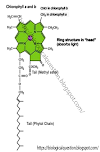Structure of RNA (Ribonucleic Acid)
General Structure of RNA :
RNA (ribonucleic acid) is a nucleic acid that plays a crucial role in gene expression. The general structure of RNA is similar to that of DNA, but with a few key differences.
RNA is typically a single-stranded molecule, whereas DNA is double-stranded. The four nucleotide building blocks of RNA are adenine (A), guanine (G), cytosine (C), and uracil (U). Uracil replaces thymine (T), which is found in DNA.
The structure of RNA can be divided into three main parts: the sugar-phosphate backbone, the nitrogenous bases, and the ribose sugar.
The sugar-phosphate backbone is made up of repeating units of ribose sugars and phosphate groups. The ribose sugars are connected to each other by phosphodiester bonds, forming a long chain.
The nitrogenous bases are attached to the ribose sugar molecules, and these bases are responsible for the genetic code carried by RNA. The bases are adenine, guanine, cytosine, and uracil. These bases form hydrogen bonds with complementary bases on another RNA molecule or with DNA, which helps in gene expression.
The ribose sugar in RNA is slightly different from the deoxyribose sugar in DNA, as it contains an extra oxygen atom. This difference in sugar structure is responsible for the instability of RNA compared to DNA.
Overall, the general structure of RNA is a single-stranded molecule with a sugar-phosphate backbone and nitrogenous bases, including adenine, guanine, cytosine, and uracil.
Types of RNA (Ribonucleic Acid) :
There are three main types of RNA molecules that are involved in gene expression: messenger RNA (mRNA), ribosomal RNA (rRNA), and transfer RNA (tRNA).
Messenger RNA (mRNA): mRNA carries the genetic information from DNA to ribosomes, where it is used as a template to synthesize proteins. mRNA is synthesized by RNA polymerase, which uses the DNA template to create a complementary RNA strand. mRNA is typically a single-stranded molecule that contains the genetic code in the form of a series of codons (triplets of nucleotides).
Ribosomal RNA (rRNA): rRNA is a structural component of ribosomes, which are responsible for the synthesis of proteins. rRNA makes up the bulk of the ribosome and helps to catalyze the formation of peptide bonds between amino acids during protein synthesis.
Transfer RNA (tRNA): tRNA is responsible for bringing amino acids to the ribosome during protein synthesis. tRNA has a unique three-dimensional structure that allows it to recognize specific codons on the mRNA and carry the corresponding amino acid to the ribosome. Each tRNA molecule carries a specific amino acid, and there are multiple tRNA molecules for each amino acid.
Diagram of Transfer RNA (tRNA)
There are also other types of RNA that play important roles in gene expression, such as small nuclear RNA (snRNA), small nucleolar RNA (snoRNA), and microRNA (miRNA), among others. These RNA molecules are involved in various aspects of RNA processing and regulation of gene expression.
Diagram of RNA (Ribonucleic Acid)
Thank you for Reading the article.


.png)

.png)


0 Comments